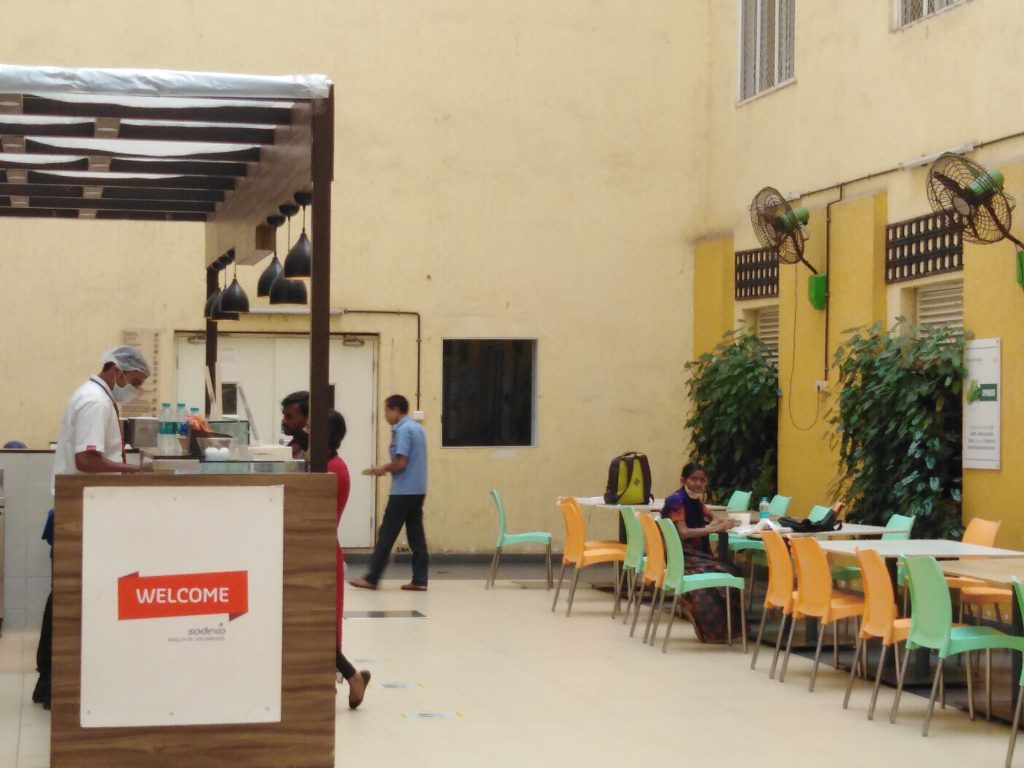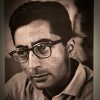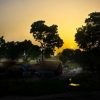Goa is abuzz with excitement as vintage bike and car owners, users, collectors and fans are decking […]

EATING HOSPITAL FOOD!
Life & Living, Mar 06- Mar 12, 2021 March 5, 2021Manipal hospital canteen experience… patient’s thali meal in a room; educative posters put up in atrium restaurant-cum-canteen
By Tara Narayan
FUNNY or not funny. In and out of hospitals quite often I take a keen interest in what patients get to eat and over recent years have seen a steady marginal improvement of nutritionally conscious food! No longer do patients either in public hospital or private hospital get the indifferently greasy, salty, over spiced masses of food which used to arrive in the old days, washed down with copious dark watery tea with or without refined ugly pau loaves. Going cheap naturally.
But then those were days when few thought food or what you put in your mouth is important and had a bearing on the status or quality of the health one enjoyed or suffered from. Then the Sodexo people started getting the hospital and other corporate foodie contracts and I noticed that food at both the GMC and Manipal hospitals became reasonably edible regardless of whether a patient wanted to eat it or not; patient’s attendant was happy to consume and appreciate it — while sahib ate thoughtfully provided tiffin fare from home!
Mind you, this time around at the Manipal hospital I noticed the Sodexo food served to patients is marginally different from the one served to patients – it’s more conscious of little usage of refined oil, salt, spices…the recent thali lunch I got over lunch time at the Manipal hospital last week was interesting in the sense that it comprised a bowl full of salad – cucumber and carrot sliced into sticks, but what’s the point if you’re a senior patient with denture and lazy to chew?
Senior patients want nutritious yet softer, easily chewed food! With dentures it’s more difficult to chew a hard salad of carrot and even cucumber! Grated is far superior for them. It makes a difference to them, it makes a difference to poor or better digestion. My friends, go ask all the top notch wellness clinics of Europe, the first day itself they make you learn how to chew your food 20 times or more. What you eat and how you eat it is as important as pining for good health!
A basic thali meal is generally speaking more well balanced nutritionally – like this one at the Manipal hospital which came with little katori of sabzi, dal, thick and flavorful; pulao; curd (so and so and I wondered if it was freshly made curd, curd is a probiotic you must know, aids digestion, eat salad and curd first), along with two very nice thinner chappati (not the same as the thicker ones served at the hospital’s atrium-styled canteen restaurant, but then again some folk like their chappati thin as in pulka and some don’t mind thicker heavyweight affairs). Smart dieticians come around to judicially enquire about a patient’s diet but oftentimes have little commonsense.
The Manipal atrium restaurant canteen too is managed by Sodexo and here one may find a mix of indifferent and desirable snacks and of course there’s a thali meal deal here too for Rs100 or so. I prefer the patient’s thali but the canteen Sodexo thali too is fine. Better than many a thali out in the popular Panaji eateries for Rs120 now post-covid-19 lockdowns. If Manipal hospital a little more closely located to where I stay I’d go eat the Sodexo thali here occasionally! Funny, with all the drool-worthy posters up about why to eat broccoli, spinach, walnuts, etc….none of the recipes in the thali meal deal features these superfoods. Except may be spinach as in alu-palak or palak-paneer.
But (sigh) there are still no alternative to wheat chappati unless one wants to take refined white bread slices in lieu! The fact is many react to today’s widely genetically modified wheat flour and are switching over to far more agreeable jowari (sorghum) or ragi (red millet, also nachne) or bajra (pearl millet) roti which folk still prefer to eat in Goan country homes. It no longer elitist to be eating geu-ki-atta-ki chappati, unless you can lay your hands on non-GMO wheat flour and gluten doesn’t bother you.
We have such a fabulous range of alternate Indian breads or roti in our local cultures and I wonder why we find them disagreeable and so hard to find in the marketplace! Of course it is hard to find good buttermilk or fruit or veggie juices or even combo fruit-veggie green juices even in the Sodexo canteen food quite simple because of the difficult logistics involved and most folk don’t patronize the juices. These days one is advised to begin the day with a green veggie cocktail or smoothie to be more correct. Smoothies are all the rage for health-seekers and these will feature such greens.
CATARACT SURGERY
WHY was I at the Manipal hospital? This time it was me. Every time I have a health decision to make it’s a difficult shall I go to the public GMC hospital or take the easier way out and go to the nearer private Manipal hospital, some say is the five-star hospital of Panaji, but I’m not saying that!
Both private Manipal and public GMC hospitals have different advantages to offer. The main one being that of cost naturally. Quite simply the GMC is more cost-effective, never mind the rest of the story of poor housekeeping in washrooms/toilets, availability of senior doctors, the amount of walking a patient may have to do if none of the dangerously wieldy wheelchairs are available…plus, at the GMC I would have been shoved from here and there with documentation to process and may never be sure which doctor or intern or Ayurveda trainee performed the surgery.
In the end I told myself forget hanging on to some money in these difficult, traumatic covid-19 times and go to the doctor one trusts from past experience! I went to the down-to-earth Dr Kaushik Dhume who did my last right cataract surgery three years ago; asked him whether I should do my left eye immature cataract giving me trouble? After meticulous examination he said I should do it and so I trusted him with my last one original eye! Hey, lots of differences between one’s own natural eye and artificial lens eye…and so it was done with some rough patches, I was down with a cold and thought I’d be coughing throughout the surgery. But magically I didn’t feel like coughing even once.
But Manipal hospital is Manipal hospital and it cost me something like Rs50,000 for the cataract operation; mercifully insurance paid at least 60percent of it after fussing with insurance documentation. For this I will thank the hospital’s first-class team who do the online paperwork between insurance claimant and insurance company. I mean if one is a patient one is hardly likely to be doing all this, on my mind was my cataract-ridden eye and whether all would go off well. Even learning how to put eye drops in the eye by oneself takes some learning.
To make matters worth if the insurance company contests some of the hospital billing, that’s it; one is stuck in the hospital until the billing is resolved.
This is to say generally speaking I have a cordial love-hate relationship with healthcare in this country and even in Goa where it’s loudly trumpeted that everyone has a government-sponsored DDYS insurance and in any case most monied Goans have other insurance too…so they can call at any one of the so called five-star hospitals of Goa and stay for as long as they please! I think there should be fewer hospitals and more sanitoriums of the old-fashioned kind where many patients (including many senior patients) may not be aggressively treated to a plethora of diagnostic tests purely for billing purposes.
To be honest I like the idea of setting up people’s cooperative hospitals on the lines of Sushrusha Citizens’ Co-operative hospital in Dadar, Mumbai. Monsterously large private hospitals I have seen have no sense of economy and will keep bright lights on all the time even in rooms and even they run out of water in the bathrooms…bed sheets may be less than perfectly clean and if one is feeling cold because of all the air-conditioning, one may have to beg the nurse for a decent blanket even in the daytime.
Not funny, whenever I’m at the Manipal hospital I wish it was a public hospital instead of a private one! If you’re asking me if I’d rather have a first class hospital for both aam and khaas aadmi or Ram Mandir in Ayodhya — I’d say first class free healthcare for all…only then we may call oneself a well-governed progressive country! Panaji can do with smaller public hospitals for the people of Panaji to avail of first class health services without losing an arm and a limb. I don’t see why Manipal hospital cannot double as a public hospital partially – let the GMC run it!
After all it was the old public charitable cancer hospital once upon a time which sold out for a song to private healthcare pushers. I know many old timers in Goa who still rue the fact that so much of land belonging to the original trust sold off so dirt cheap for building of the grand Manipal hospital! It’s one of Goa’s medical scams or so I am told. With the diabolical waste and want I’ve seen in private hospitals, I’m all for smaller co-operative hospitals coming up where citizens have a stake.
In smaller hospitals there’s no quick turnover of staff and one pretty much knows the doctors roll-call and nursing staff, they’re easier to maintain sanitized and of course inflationary billing by hook or by crook is not the main brief. A smaller hospital may also function better as half a sanitorium for those who just need nursing and nourishing with a TLC touch. Smaller public hospitals, smaller co-operative citizens hospitals…a hospital in every village or nearby town. Where preventive healthcare goes hand in hand with treatments and where one may avail of wholesome meals to eat or take away. I don’t know why our hospitals don’t offer such desirable Goan fare as red rice pez or amboli dosa or sannam-choon! Or even the Goan bakery roll-call of breads, mainly decent poie.
These are my thoughts this week and back home now I’m still trying to follow the good doctor’s instructions of no head bath for a week and don’t forget the eye drops which I tend to do. My real moveable eyes are now gone in exchange for false immoveable lens eyes…and I’m still feeling strange trying to adjust. Like maybe I’m one quarter dead or something like that, so better start appreciating the rest of my days, weeks, months, years left on the good earth.
Just some facts of life and cost of healthcare at the Manipal hospital….
• A taxi driver charged me Rs400 from Caranzalem where I live to Manipal hospital at Bambolim plateau. It’s the minimum rate now no matter how short the distance! I wish I’d gone by my scooter and saved the money after all media people are not exactly wealthy and last year’s covid-19 lockdowns just about killed them out of existence.
• Why does Manipal hospital doctors tell patients to present themselves on the day of OPD surgery at 6.30 am? When the hospital staff itself at the reception is yet to make an appearance at 8am or later? The watchman lets patients in but they are left to wander around by themselves in search of any help and where they may wait in peace! No tea, no water. No one to help fill consent forms, to help drop eye drops in their eyes as they have been advised. ODP patients do not have a room where they may be monitored for day care surgeries before and after and their data filed. They are also required to change into hospital attire which is so ridiculous – mismatched pyjama-tops either too tight or too loose (donated by some charity perhaps), with enough strings inside and outside to tie up fumblingly, or the entire attire is in danger of falling apart wherever! As it is one may wait endlessly for one’s turn in the OT. You may be in the hospital all day long but may stay hungry unless you have brought you own lunch and tea with you all the way from Mapusa or wherever.
• All this despite the Rs400 registration charges day OPD patients pay every time they come in for a consultation with the doctor till it is D-day or surgery day.
• If you are lucky and somebody listens to you a bed in a ward may be assigned for the use of a patient, but since the day patient is on call for surgery at whatever time allotted for the operating theatre …one may wait forever for nursing staff to take an interest in you.
• Said one patient along with me: It’s far more efficient at the GMC hospital although there are too many people there!
• Small, local, public hospitals are the need of the hour in the near future, that is if Chief Minister Pramod Sawant’s government is interested. Preferably aided cooperative hospitals run along no profit, no loss basis but which provide healthcare with a capital H.















